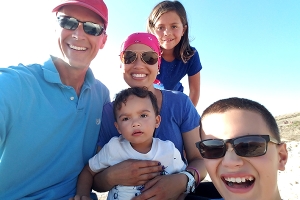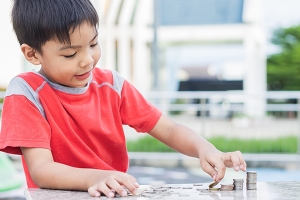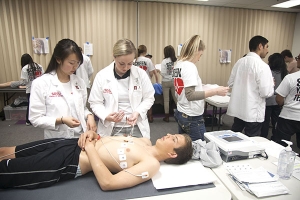
Anxiety in kids is on the rise, and it doesn’t take too much digging to uncover some of the reasons why. With increased pressure inside and outside of the classroom, children’s performance is measured in everything from academics to athletic ability starting as early as preschool. Schedules are packed with little or no time for rest. Face-to-face conversations have been replaced with texting and social media where kids get a steady diet of comparison and competition to get “likes” and be noticed. With these and other factors added to normal stressors of growing up, children need help learning how to safeguard themselves against anxiety overload.
Understanding Anxiety
Occasional anxiety is a normal part of life. Starting school, taking tests, learning to drive and public speaking are all examples of everyday events that can trigger the brain’s natural “fight or flight” response to fear. Chemicals are released into the body that cause increased heart rate, muscle tension, sweaty palms and shortness of breath. Situations that cause anxiety happen to everyone. But when fear lingers and extends beyond common stressors, kids and families can feel overwhelmed.
Warning Signs
Symptoms of anxiety take many forms and look different from child to child, so knowing how your child typically behaves helps parents recognize warning signs. Some kids experience physical symptoms such as loss of appetite, headaches and stomach problems. Others avoid or withdraw from seemingly fearful situations. Angry outbursts or opposition can also indicate increased stress. Watch for changes in behavior or out of the ordinary reactions that might indicate excessive anxiety.
How to Help
Anxiety can be contagious in families, so the first line of defense for parents is to manage how they respond to their child’s fears. According to Kathryn de Bruin, a San Diego marriage and family therapist, parents often fall into a negative pattern of becoming anxious when their child is anxious. “A parent’s number one job is to help children regulate and calm themselves because nothing good comes from an anxious brain,” she says.
An anxious parent might decide that the best way to reduce anxiety is to avoid stressful situations. However, avoidance reinforces fear of the unknown and can make things worse. “Show children you’re taking them seriously, but that you’re not afraid. If you’re not anxious about their anxiety, they feel safe,” says de Bruin. Stay calm and encourage kids to practice facing discomfort — a more effective solution in the long term.
Go Back to Basics
Be sure everyone is getting enough rest, exercise, nutritious food and fun. Take a look at the family calendar and resist pressure to overcommit — set boundaries and limitations. As kids grow, keep an open line of communication about expectations. Increased expectations without discussion can lead to misperceptions and added stress in older kids and teens, so keep talking about priorities.
Talk it Out
Talking uses a different part of the brain than worrying, so it gives troubled minds a rest. But talking about what’s causing anxiety can be hard for kids because it stirs up the negative feelings they’re trying to avoid. My own son struggled with anxiety throughout middle school. I felt helpless as my attempts to get him to talk about his feelings were met with silence. Now a senior in college, I asked what we could have done to make those years better for him. He said simply knowing he had people to talk to helped, even when he didn’t take them up on the offer.
You can’t force a conversation, but you can pay attention when kids do want to talk, such as in the car or at bedtime. Let kids share what they want, so they feel comfortable. My son recalls, “Sometimes it was nice to have someone who wanted to talk about normal things and didn’t want to talk about the elephant in the room.”
Respond Positively
Listen carefully for underlying feelings of inadequacy, fear of failure or rejection and don’t try to talk kids out of feeling anxious. “A cognitive, rational response like ‘There’s no reason to be anxious’ often falls short,” says de Bruin, “because the frontal lobe is not accessible for cognitive logic when the brain is stressed. Instead, stay positive and try saying something like, ‘Oh! I think you’re anxious’ or ‘Sounds like the brain bully is back’ and then give your child some strategies to try.”
Distractions such as deep breathing, holding ice cubes or focusing on silence give the brain a break and disrupt the pattern of worry and fear. Movement helps, so encourage kids to stand up and stretch, run in place, do jumping jacks, or go for a walk. Older children can journal their thoughts or create art to express feelings. Touch is therapeutic at every age, so offer a hug or back massage.
Ask a Professional
Left unchecked, anxiety can cause low self-esteem, decreased success in school, problems with friends and strain on families. Untreated anxiety disorders can lead to more serious mental and physical health problems. If fear and anxiety persist, talk to your pediatrician — a qualified professional can help.
Parents can’t give children a stress-free world, but we can help kids learn to manage increasing pressures of life by equipping them with strategies and safeguards against the harmful effects of prolonged and persistent anxiety.
__________
Jody Lee Cates is a local mom and blogger who writes about healthy relationships at www.jodyleecates.com
Find more resources for anxiety at San Diego Kids First (www.sdkidsfirst.com) and Special Needs Resource Foundation of San Diego (www.SNRFSD.org).
__________



















